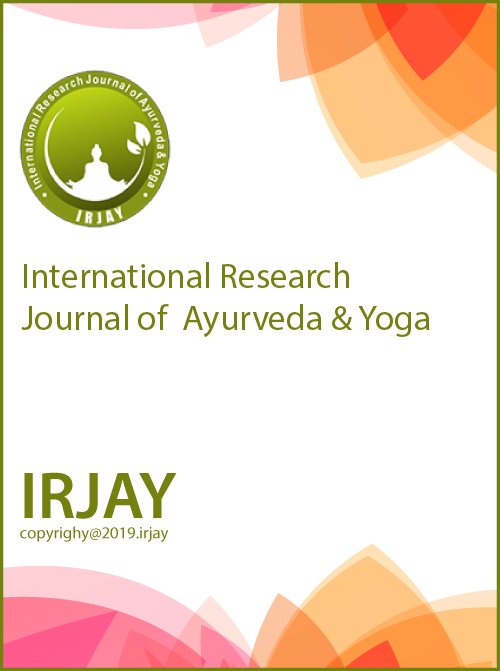A Review on the Nadi Vikriti w.s.r to Pranavaha Strotas
DOI:
https://doi.org/10.48165/Keywords:
nadi vigyan, nadi, pranvaha strotas, pulseAbstract
Treatment in Ayurveda is not all similar as the modern medicine. Ayurveda is based on various siddhanta’s such as tridosha, panchamahabhoota, sapta dhatu, dashvidha parikshya bhava to name a few. The prognosis of a patient or the severity of a disease cannot be decided by a single thing. We use rogi-rog pareeksha to identify diseases. Dashvidh pareeksha is used to evaluate the patient, whereas panch-nidan pareeksha is used to diagnose the ailment. To determine a disease's cause, a questionnaire must be created. By simply sensing the radial artery's or any other pulsating artery's pulse, this diagnosis can be made with the use of nadi vigyan. Hrudya, mahastrotas & rasvahai dhamniya forms the moola of pranavaha strotas (Channels carrying vital life element). As the name indicates prana is something in which the life flows. In other words, pranavaha strotas play an important role in maintaining life energy, if not it can lead to death. So, it is important to know nadi vikriti which arises due to the physiological disturbances in the pranavaha strotas.in this paper we will review on the nadi vikriti with special reference to diseases related to pranavaha strotas, which can be achieved through appropriated knowledge and practice of its nadi pareeksha (Pulse diagnosis).
Downloads
References
Athavale V.B., Pulse, Delhi, Chaukhamba Sanskrit Pratisthan, 2017, p.1
Athavale V.B., Pulse, Delhi, Chaukhamba Sanskrit Pratisthan, 2017, p.2
Athavale V.B., Pulse, Delhi, Chaukhamba Sanskrit Pratisthan, 2017, p.14
Athavale V.B., Pulse, Delhi, Chaukhamba Sanskrit Pratisthan, 2017, p.24
Shastri K, Vidyotini Hindi Commentary, Charaka Samhita, Viman Sthana, Chapter 5, Shloka No. 7, Chaukhamba Bharati Academy, Varanasi 2009.pp.710 6. Shastri AD, Hindi Commentary, Sushruta Samhita, Sharir Sthana, Chapter 9, Shloka No. 11, Chaukhamba Sanskrit Sthana , 2009.pp.96
Shastri K, Vidyotini Hindi Commentary, Charaka Samhita, Viman Sthana, Chapter 5, Shloka No. 7, Chaukhamba Bharati Academy, Varanasi 2009.pp.710 8. Shastri AD, Hindi Commentary, Sushruta Samhita, Sharir Sthana, Chapter 9, Shloka No. 11, Chaukhamba Sanskrit Sthana , p.96
Shastri K, Vidyotini Hindi Commentary, Charaka Samhita, Sutra Sthana, Chapter 11, Shloka No. 49, Chaukhamba Bharati Academy, Varanasi 2009.pp.237 10.Katyayan A, Vivechani Hindi Vyakhya, Nadi Vigyan( Kanada), Shloka 82, Chaukhamba Subharati Prakashan, Varanasi, 2015 p.49
Shastri SL, Hindi Commenrary, Yogratnakara, Chapter Nadi Pariksha, Shloka No. 23, Chaukhambha Sanskrit Series Office, 1973, p.8
Tripathi I, vaidyaprapha bhashateeka, nadi pareeksha ( ravankrita) shloka 56-57, chaukhamba orientalia, 1982, pg 15
Katyayan A, Vivechani Hindi Vyakhya, Nadi Vigyan ( Kanada), Shloka 95, Chaukhamba Subharati Prakashan, Varanasi, 2015 p.52
Tripathi I, vaidyaprapha bhashateeka, nadi pareeksha ( ravankrita) shloka 61, chaukhamba orientalia, 1982, pg 16 15.Katyayan A, Vivechani Hindi Vyakhya, Nadi Vigyan (Kanada), Shloka 108, Chaukhamba Subharati Prakashan, Varanasi, 2015 p.58
Katyayan A, Vivechani Hindi Vyakhya, Nadi Vigyan (Kanada), Shloka 110, Chaukhamba Subharati Prakashan, Varanasi, 2015 p.59
Katyayan A, Vivechani Hindi Vyakhya, Nadi Vigyan (Kanada), Shloka 114, Chaukhamba Subharati Prakashan, Varanasi, 2015 p.61
Tripathi I, Vaidyaprapha Bhashateeka, Nadi Pareeksha (Ravankrita) Shloka 32, Chaukhamba Orientalia, 1982, p.10
Katyayan A, Vivechani Hindi Vyakhya, Nadi Vigyan ( Kanada), Shloka 109, Chaukhamba Subharati Prakashan, Varanasi, 2015 p.59
Katyayan A, Vivechani Hindi Vyakhya, Nadi Vigyan ( Kanada), Shloka 116, Chaukhamba Subharati Prakashan, Varanasi, 2015 p.63
Tripathi I, Vaidyaprapha Bhashateeka, Nadi Pareeksha ( Ravankrita) Shloka 61, Chaukhamba Orientalia, 1982, p. 16
Tripathi I, vaidyaprapha bhashateeka, nadi pareeksha ( ravankrita) shloka 59, chaukhamba orientalia, 1982.pp. 16
Tripathi I, vaidyaprapha bhashateeka, nadi pareeksha ( ravankrita) shloka 59, chaukhamba orientalia, 1982, p. 16 24. Drake M. William Hutchison’s Clinical Methods, Elsevier, 2012, p. 172
Drake M. William Hutchison’s Clinical Methods, Elsevier, 2012, p.173
Drake M. William Hutchison’s Clinical Methods, Elsevier, 2012, p.173-174
Innes J Alastair, R Dover Anna & Fairhurst Karen, Macleod’s Clinical Examination, Elsevier, 2018, p.47 28. Innes J Alastair, R Dover Anna & Fairhurst Karen, Macleod’s Clinical Examination, Elsevier, 2018, p.48 29. Innes J Alastair, R Dover Anna & Fairhurst Karen, Macleod’s Clinical Examination, Elsevier, 2018, p.48 30. Innes J Alastair, R Dover Anna & Fairhurst Karen, Macleod’s Clinical Examination, Elsevier, 2018, p.49 31. Innes J Alastair, R Dover Anna & Fairhurst Karen, Macleod’s Clinical Examination, Elsevier, 2018, p.49 32. Innes J Alastair, R Dover Anna & Fairhurst Karen, Macleod’s Clinical Examination, Elsevier, 2018, p.49 33. Drake M. William, Hutchison’s Clinical Methods, Elsevier, 2012, p.173
Pabba K, Safadi AO, Boudi FB. Water Hammer Pulse. [Updated 2022 Aug 8]. In: StatPearls [Internet]. Treasure Island (FL): StatPearls Publishing; 2022 Jan- . Available from:
https://www.ncbi.nlm.nih.gov/books/NBK526118/ 35. Drake M. William Hutchison’s Clinical Methods, Elsevier, 2012, p.173

